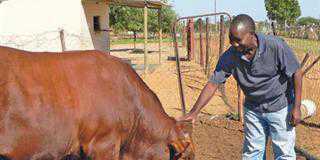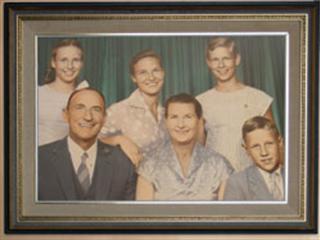
Jacobus van Heerden Coetzee grew up in the Karoo where he attended a small farm school, then Cradock Primary, Cradock Boys High and Grey College in Bloemfontein (1928-1929). He remembers the Afrikaans-speaking pupils being punished for not speaking English properly.
“We were made out to be donkeys if we dared to speak Afrikaans. I am partial to languages and became proficient in English, but my heart used to bleed for those who were not. Anyway, I was put into the Afrikaans class at Grey and really had to apply myself to catch up since I was so used to English.”
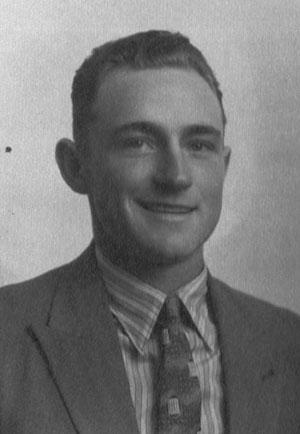
Oom Jacob, aged 20.
Oom Jacob is the oldest Old Grey. He had to leave school at the end of grade 10 to help out on the farm because of his father’s poor health after the 1918 flu epidemic. Oom Jacob remembers the time of the flu and says he has seen many terrible things during his life.
“I was 6 years old when the flu broke out and remember times of suffering and death. I also experienced the great drought of 1933 and the ensuing economic depression. Remember, those disasters occurred not long after the Anglo-Boer War when farmers were penniless. I resolved to make something of myself and eventually completed matric though a correspondence course in 1935. I wanted to become a vet but there was no money.”
Marriage and family
When he was in his 20s Jacob met Sannie van der Merwe, daughter of Hennie van der Merwe of Holfontein in the Ottosdal district. The couple married shortly before Oom Jacob’s 30th birthday and settled on the farm Mahemsvlei near Klerksdorp. Tannie Sannie’s mother died in the 1918 flu epidemic and she subsequently inherited the farm from her grandfather, Commandant Hendrik Badenhorst and his wife Bettie. Tannie Sannie died three years ago aged 91.
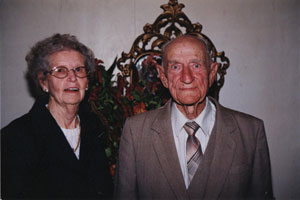
The couple on their 60th wedding anniversary.
Recounting a story of Hendrik Badenhorst, Oom Jacob says, “During the war, he and Ouma Bettie were questioned by an English officer who wanted to know if there was money hidden at Mahemsvlei. The officer marched up to the house and came to a standstill on the stepping stone in front of the door. The couple said they had no money and the house was searched by the enemy, to no avail. But the Badenhorsts’ money was hidden under the very stepping stone on which the officer was standing.”
He recalls another story of Tannie Sannie’s paternal grandmother, Sannie van der Merwe, and her bravery during the war. She remained on the farm with the children while the men went off to fight. Shortly after the birth of one of her children, the English arrived to cart the family off to a concentration camp. Ouma Sannie was still recuperating and the officer undertook to fetch them the following week. As soon as they had left, she commandeered the workers and children to span the oxen in and she and the family fled. She and her children stayed on the move and dodged the English for the remainder of the war.
Trekking North
After marrying Tannie Sannie, Oom Jacob moved from the Karoo to the North West by train. Furniture, equipment, livestock and even an ox wagon was loaded at the Beroda station near Cradock and offloaded in Klerksdorp. The wagon and mules shipped up on the train were used to transport everything to Mahemsvlei.
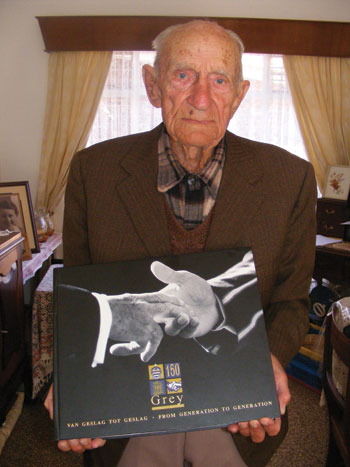
Oom Jacob completed grade 10 at Grey College in 1929.
“We really had to start from scratch. I planted maize and farmed with Afrikaner cattle. I used oxen and mules to plant and cultivate. Tractors such as the Ferguson Vaaljapie were available at the time, but I could not afford one. With well- trained oxen and mule spans, the ploughing and planting went relatively smoothly, but it was back-breaking work. We yoked the oxen and mules long before sunrise and continued till about noon. The animals were then watered and turned out to graze till about 2pm when they were inspanned again until sundown. The longevity of a span of oxen was five years at the most. Breaking in young oxen is terribly hard work.”
Afrikaner cattle
Oom Jacob believes Afrikaner cattle are the most economic beef breed in South Africa because of their hardiness and adaptability. He places great value on the strong mothering instinct of the Afrikaner cow and maintains that it is the most intelligent and the bravest of breeds. Oom Jacob tells the story of an Afrikaner bull in Hoopstad that came in from the veld bloodied and wounded. “After the bull had been treated for its wounds, the site of the attack was inspected and the body of a male lion was found. The bull had killed the lion with a swipe of its horn directly into the heart.”
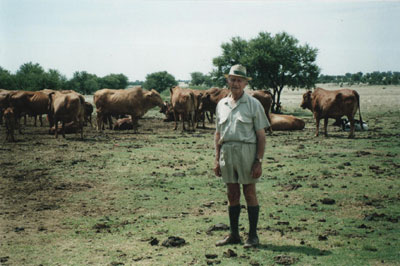
Oom Jacob on his farm Mahemsvlei with his Afrikaners.
Community and change
Oom Jacob started the Mahemsvlei Farmers’ Association a few months after his arrival and served as chairperson for 30 years. When he retired 26 years ago, he transferred his membership to the Hartbeesfontein Agricultural Association where he remains an honorary member. He ascribes his personal success to the fact that he read voraciously and continues to do so, keeping abreast of the latest agricultural developments.

The farmhouse at Mahemsvlei.
Oom Jacob has seen agriculture in South Africa change from subsistence-style to commercial farming. “We harvested maize by hand and now it is done by air- conditioned harvesters. Input costs have risen tremendously, so much so that maize seed now costs one cent per kernel. We planted old-fashioned seed such as Hickory King with small yields. Advanced seed cultivars have revolutionised grain production and increased yields dramatically.”
He still drives his own bakkie, walks without a cane and is in excellent health. Hartbeesfontein agricultural association manager Claudine le Roux describes Oom Jacob as a gentleman and someone who has contributed enormously to the development of commercial agriculture in Klerksdorp and the surrounding districts. Oom Jacob advises young farmers never to stop learning and to stay away from brandy and debt.
Oom Jacob’s words of wisdom
- Keep your eyes and ears open in the company of people who know more than you do.
- The most productive work is the work you do yourself.
- The only acceptable debt is the purchase of land, your most important investment.
- A motor vehicle is second- hand the moment it leaves the dealer’s showroom.













